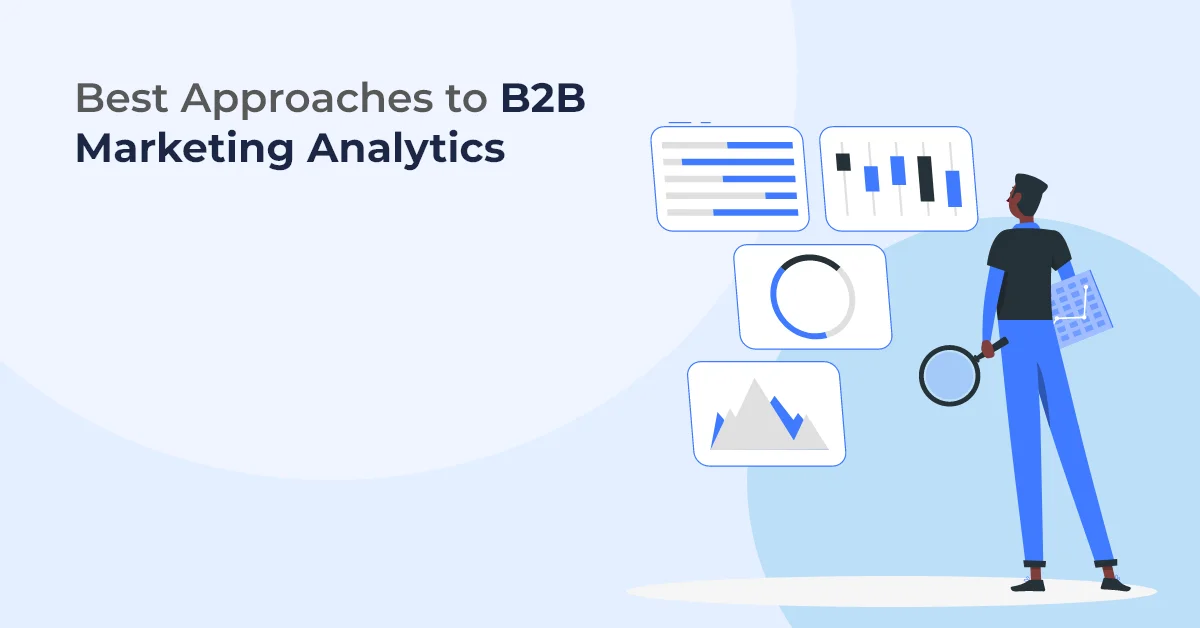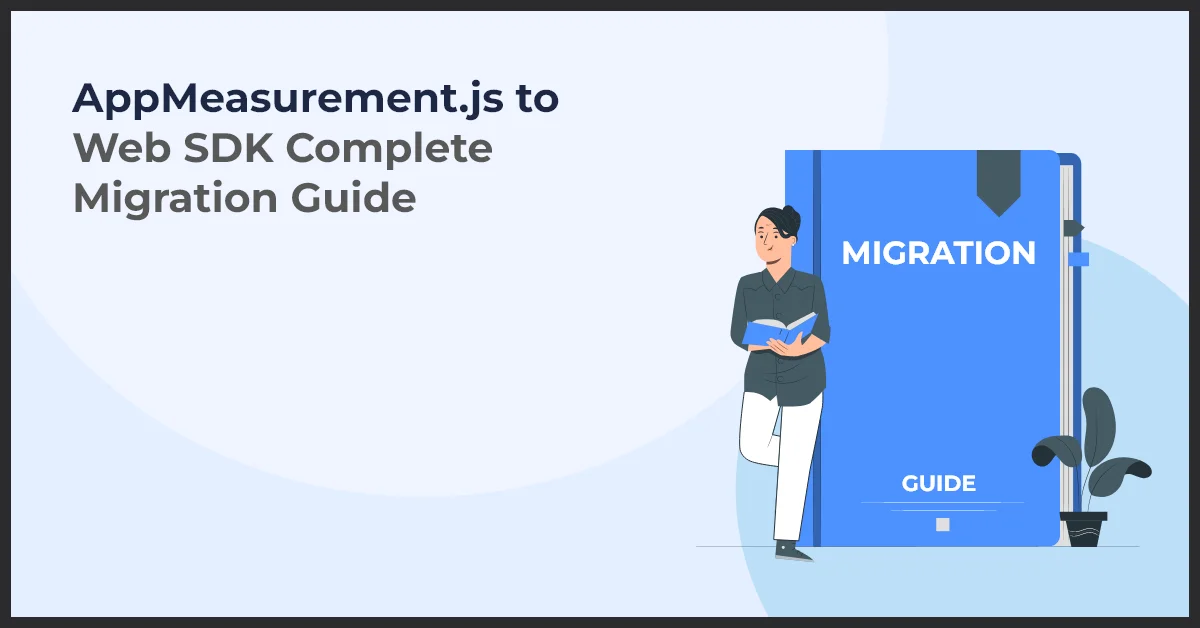Key Methods to Leverage B2B Marketing Analytics for Growth

Published on: June 15, 2021
Updated on: March 11, 2025
1861 Views
- Analytics
17 min read
B2B Marketing Analytics is your trusted sidekick when it comes to getting insights into your business operations and campaign performance. Using B2B analytics, you can gather the important data essential to your ultimate success and nurture keen insights that lay the foundation of a successful business strategy.
Nevertheless, as companies look to make the most out of the many analytical options available to them, they often struggle to choose a strategy that best fits their requirements.
A successful marketing analytics strategy makes the best use of real-time analytics, AI, and automation. As a result, marketing experts today look toward data-driven marketing tools more than ever before.
If you are also wondering how to use data to your best advantage, we have compiled some of the best approaches to B2B marketing analytics that you can use without breaking a sweat.
The Power of B2B Marketing Analytics: Driving Success through Data
In today's fast-paced business world, staying ahead of the competition requires more than just a great product or service. It requires a deep understanding of your target audience, their behaviors, and the effectiveness of your marketing strategies. That's where B2B marketing analytics comes in.
B2B marketing analytics refers to the process of measuring, analyzing, and interpreting data to improve marketing campaign performance, generate valuable insights, and make data-driven decisions. It plays a crucial role in helping businesses enhance their marketing strategies and achieve their goals.
By leveraging data and analytics, B2B marketers gain a deeper understanding of their target audience's preferences, pain points, and purchasing behaviors. This valuable information enables them to create more targeted and personalized marketing campaigns, resulting in improved customer acquisition, retention, and revenue growth.
Furthermore, B2B marketing analytics allows businesses to measure the effectiveness of their marketing efforts accurately. It provides insights into which channels, content, and campaigns are driving the most engagement, leads, and conversions. With this knowledge, marketers can optimize their strategies, allocate their resources effectively, and maximize their return on investment.
In a rapidly evolving business landscape, B2B marketing analytics has become an essential tool for any company looking to gain a competitive edge. It empowers businesses to make informed decisions, streamline their marketing efforts, and ultimately drive success through the power of data.
Understanding B2B Marketing
B2B marketing, or business-to-business marketing, is a unique field that involves selling products or services from one business to another. It differs from B2C, or business-to-consumer, marketing in several key ways.
Overview of B2B Marketing and Its Unique Challenges
In B2B marketing, the target audience consists of other businesses and professionals. This means that the marketing strategies and tactics used must be tailored to the specific needs and preferences of businesses. Additionally, the sales cycles in B2B marketing tend to be longer and more complex.
- Higher average order values and longer sales cycles make it crucial to have a deep understanding of your target market and their buying process.
- Building strong relationships with key decision-makers within businesses is essential for success in B2B marketing.
- B2B marketing often involves selling products or services that are highly technical or specialized, requiring a knowledge and expertise that is not always necessary in B2C marketing.
Key Differences between B2B and B2C Marketing
While B2B and B2C marketing share some similarities, there are key differences that marketers must understand in order to create effective campaigns. Some of these differences include:
- The target audience: B2B marketing focuses on other businesses, whereas B2C marketing targets individual consumers.
- The buying process: B2B purchases typically involve multiple decision-makers and a longer sales cycle, while B2C purchases are often made by individuals in a shorter timeframe.
- The messaging: B2B marketing tends to be more focused on demonstrating value, solving business challenges, and building trust, while B2C marketing often appeals to emotions and desires.
Importance of Data-Driven Decision Making in B2B Marketing
When it comes to B2B marketing, data-driven decision making is crucial. By analyzing and interpreting data, marketers can gain insights into their target audience, improve campaign performance, and make more informed strategic decisions.
With data analytics, B2B marketers can:
- Identify the most effective marketing channels and tactics for reaching their target audience.
- Personalize marketing messages and offers based on customer preferences and behaviors.
- Measure the success of marketing campaigns and make adjustments to optimize performance.
Data Analytics in B2B Marketing
A. Importance of Data in B2B Marketing
In the world of B2B marketing, data is at the core of every strategic decision. By harnessing the power of data, businesses can gain valuable insights into their target audience and their preferences. Data-driven decision making enables businesses to make informed choices that lead to better outcomes.
When it comes to B2B marketing decisions, data plays a crucial role in understanding customer behavior and preferences. By analyzing data, businesses can uncover patterns and trends that can help them tailor their marketing strategies to better resonate with their target audience.
B. Data Sources for B2B Marketing Analytics
In B2B marketing analytics, it is important to have access to various sources of data for a comprehensive analysis. These sources include first-party, second-party, and third-party data.
First-party data is the data collected directly from a company's own customers and prospects. It includes information such as demographic data, purchase history, and customer feedback. Second-party data is obtained from trusted partners or alliances, while third-party data is purchased from external sources.
The significance of these data sources lies in the different perspectives they offer. First-party data provides deeper insights into existing customers, second-party data helps expand the reach to new audiences, and third-party data fills in the gaps with additional information.
C. Leveraging Salesforce for B2B Marketing Analytics
Salesforce, a renowned customer relationship management (CRM) tool, can greatly enhance B2B marketing analytics. It offers numerous benefits for businesses seeking to capture and analyze customer data for better insights.
By utilizing Salesforce, businesses can effectively track and manage customer interactions, monitor marketing campaigns, and measure the success of their marketing efforts. The platform also enables businesses to segment their audience, personalize marketing messages, and identify potential upsell and cross-sell opportunities.
B2B Marketing Analytics Tools and Techniques
In the rapidly evolving world of B2B marketing, relying on intuition and guesswork is no longer enough to achieve success. To stay competitive, businesses need to leverage the power of data analytics to make informed decisions and drive their marketing strategies forward. With the right tools and techniques, B2B marketers can gain valuable insights into their target audience, optimize their campaigns, and measure the effectiveness of their marketing efforts.
A. Key Metrics and KPIs for B2B Marketing Analytics
- Identify and define essential metrics for measuring B2B marketing effectiveness: In order to gauge the success of your marketing campaigns, it's crucial to establish key metrics and key performance indicators (KPIs) that align with your business goals. These metrics may include website traffic, lead generation, conversion rates, customer retention, and more.
- Discuss how to set goals and track progress using these metrics: Once you have defined your key metrics and KPIs, you need to set clear goals and objectives and track your progress regularly. With the help of analytics tools, you can monitor and measure the performance of your marketing initiatives, identify areas for improvement, and make data-driven decisions to optimize your strategies.
B. Building a B2B Marketing Analytics Dashboard
- Explain the purpose and benefits of a marketing analytics dashboard: A marketing analytics dashboard provides a centralized view of your key metrics and KPIs, allowing you to monitor the performance of your marketing efforts in real-time. It offers a visual representation of data, making it easier to identify patterns, trends, and anomalies. With a well-designed dashboard, you can quickly assess the effectiveness of your campaigns and make data-driven decisions.
- Provide a step-by-step guide on creating a dashboard using analytics tools: Creating a marketing analytics dashboard doesn't have to be complicated. By utilizing various analytics tools such as Google Analytics, HubSpot, or Tableau, you can easily gather and visualize your data. This step-by-step guide will walk you through the process of setting up your dashboard, selecting the right metrics, and customizing it to fit your specific needs.
C. Campaign Analysis and Optimization
- Discuss the process of analyzing B2B marketing campaigns using data analytics: Once your campaigns are up and running, analyzing their performance is crucial to refine your strategies and achieve better results. By leveraging data analytics, you can measure the impact of your campaigns, uncover actionable insights, and identify areas where improvements can be made.
- Provide insights on optimizing campaigns based on data-driven decision making: With the insights gathered from your campaign analysis, you can make data-driven decisions to optimize your marketing initiatives. This may involve A/B testing, targeting specific customer segments, adjusting messaging, or refining your overall marketing strategy. By constantly refining and iterating, you can enhance the effectiveness of your campaigns and drive better results.
Advanced B2B Marketing Analytics Strategies
A. Account-Based Marketing (ABM) and Analytics
Account-Based Marketing (ABM) is a strategic approach that prioritizes targeting specific accounts rather than casting a wide net. By defining and focusing on high-value accounts, ABM aims to deliver personalized and relevant experiences to key decision-makers.
Analytics plays a crucial role in enhancing ABM strategies by providing valuable insights and data-driven decision-making. Through thorough analysis of customer and prospect data, businesses can identify and understand their target accounts better.
Benefits of analytics in ABM:
- Improved targeting: Analytics enable businesses to identify the accounts that have the highest potential to convert, allowing marketers to allocate resources more effectively.
- Personalization: With insights from analytics, marketers can craft personalized messages and experiences tailored to the specific needs and preferences of target accounts.
- Enhanced engagement: Analytics help marketers understand how target accounts interact with various touchpoints, allowing for more meaningful and targeted engagements.
- Optimized resource allocation: By analyzing past performance data, businesses can make informed decisions on resource allocation, ensuring maximum return on investment (ROI).
B. Sales Analytics and B2B Marketing Alignment
In order to achieve marketing alignment and drive success, businesses need to integrate sales analytics into their B2B marketing strategies. By leveraging sales data, marketers can refine their campaigns, generate better leads, and align their efforts with the sales team for improved outcomes.
Key aspects of sales analytics in B2B marketing:
- Lead scoring and qualification: Sales analytics help identify the most promising leads based on behavioral data and historical customer interactions, enabling marketers to prioritize efforts and resources efficiently.
- Trend identification: By analyzing sales data, businesses can identify trends and patterns, gaining insights into what works and what doesn't in their marketing efforts. This information can be used to refine and optimize campaigns to drive better results.
- Collaboration and communication: Effective sales analytics enable seamless collaboration and communication between marketing and sales teams, allowing them to align their strategies and objectives.
- Continuous improvement: By measuring and analyzing the outcomes of marketing efforts in conjunction with sales data, marketers can continuously learn and enhance their strategies to improve overall performance.
Measuring ROI in B2B Marketing Analytics
Measuring the return on investment (ROI) is a crucial aspect of B2B marketing analytics. By evaluating the effectiveness of marketing campaigns, businesses can make informed decisions and allocate resources appropriately. In this section, we will delve into the importance of ROI analysis in B2B marketing and discuss various methods and tools for calculating ROI.
Importance of ROI Analysis in B2B Marketing
ROI analysis allows businesses to determine the profitability of their marketing efforts. It provides insights into the effectiveness of various marketing channels, campaigns, and strategies. By measuring ROI, businesses can identify which activities yield the highest returns and optimize their marketing budget accordingly. Moreover, ROI analysis helps justify marketing investments to stakeholders and demonstrates the value generated.
Methods and Tools for Calculating ROI in B2B Marketing Campaigns
Calculating ROI in B2B marketing campaigns involves comparing the costs incurred with the revenue generated as a result of those activities. Here are some commonly used methods and tools:
- Cost Recovery Method: This method involves calculating ROI based on the revenue generated specifically from the marketing campaign, subtracting the costs associated with that campaign. It provides a straightforward way to determine the campaign's impact on the bottom line.
- Incremental Revenue Method: This method assesses the additional revenue generated as a direct result of the marketing campaign. By comparing this revenue to the costs incurred, businesses can measure the overall profitability and efficiency of their marketing efforts.
- Marketing Automation Tools: Marketing automation tools offer integrated analytics capabilities that can help measure ROI. These tools track and attribute revenue to specific marketing activities, providing valuable insights into the effectiveness of different campaigns and channels.
- Customer Relationship Management (CRM) Systems: CRM systems capture and analyze comprehensive customer data, enabling businesses to track the revenue generated by individual customers and attribute it to marketing activities. This data can be instrumental in calculating ROI.
The Role of Analytics in Determining ROI Accurately
Analytics plays a crucial role in determining ROI accurately in B2B marketing. By leveraging data analytics, businesses can gain insights into buyer behavior, campaign performance, and revenue attribution. It enables marketers to track and measure the impact of each marketing activity, identify inefficiencies, and refine strategies for optimal ROI. With the help of analytics, businesses can make data-driven decisions and achieve a higher level of precision in calculating ROI.
Competitive Analysis and B2B Marketing Analytics
In the fiercely competitive B2B landscape, having a solid understanding of your competitors is crucial for success. This is where B2B marketing analytics comes into play, providing valuable insights that can give your business a competitive edge.
Using B2B Marketing Analytics for Competitive Analysis
B2B marketing analytics allows you to dive deep into your competitor's strategies, uncovering valuable information about their marketing efforts. By gathering and analyzing competitor data, you can make informed decisions and fine-tune your own marketing strategies to gain a competitive advantage.
One way B2B marketing analytics can be used for competitive analysis is by identifying your competitors' target audience. By analyzing their customer data, you can identify the industries, companies, and personas they are targeting. This information can help you refine your own target audience and tailor your marketing messages accordingly.
Additionally, B2B marketing analytics can help you analyze your competitors' content marketing efforts. By tracking their blog posts, social media activities, and other content, you can gain insights into the type of content that resonates with their audience. This knowledge can help you create more engaging and impactful content to attract and retain your target customers.
Techniques for Gathering and Analyzing Competitor Data
When it comes to gathering competitor data, there are various techniques you can employ. One effective method is social media monitoring. By monitoring your competitors' social media accounts, you can gain insights into their engagement rates, follower growth, and the types of content that perform well for them.
Another technique is website analysis. By exploring your competitors' websites, you can uncover valuable information about their product offerings, pricing, and messaging. This information can help you identify any gaps in the market that you can capitalize on.
Keyword research is another crucial aspect of competitive analysis. By identifying the keywords your competitors are targeting, you can refine your own keyword strategy and improve your search engine rankings.
Lastly, customer surveys and interviews can provide valuable insights into your competitors' customer satisfaction levels and pain points. Gathering this information can help you identify areas where your competition may be falling short, allowing you to position your business as a better alternative.
In conclusion, competitive analysis is an essential component of B2B marketing analytics. By leveraging the power of analytics, you can gain a deep understanding of your competitors and use that knowledge to refine your own marketing strategies. So, don't underestimate the importance of competitive analysis in the world of B2B marketing.
How to Get the Most Out of B2B Marketing Analytics
1. Analyze Your Lead Sources
Marketers are always curious to know where their leads are coming from; however, not much is done once the information is identified.
With B2B Marketing Analytics, it becomes easier to understand the performance of your lead generation channels and implement changes to improve in real-time.
Pro Tip: Select the Prospects dataset, and then group by using the Source field. You can also add a filter to exclude low-producing sources, and add relevant widgets to enhance your viewing experience.
2. Create Your Own Lifecycle Report
If you’re using marketing automation software like Pardot, you may feel the Pardot Lifecycle doesn’t truly reflect your company’s unique prospect flow.
For instance, Pardot may define Marketing Qualified Lead (MQL) as a prospect who has been assigned and a Sales Qualified Lead (SQL) as a prospect linked to an opportunity, but for you, both these stages could be very different.
With B2B Marketing Analytics, you get the power to create customized lifecycle reports that best suit your marketing style and strategy.
3. Align Your Grades with Revenue
A grading system can be a highly effective tool to outline the perfect buyer profile. With B2B Marketing Analytics, you can evaluate how your grading system is performing and how your graded prospects are distributed across different lifecycle stages.
Pro Tip: To create an effective grading system, combine the Prospect dataset with the Opportunities dataset, use Count of Rows as your measure, and group by Stage and Grade.
You can also use the Sankey visualization to get a more detailed view of your distribution.
4. Identify Most Engaged Prospects
When you are creating a custom grading system, identifying your ideal prospects is the most important factor.
With B2B Marketing Analytics, you can easily identify the key characteristics of your prospects and categorize them accordingly.
Pro Tip: Make sure to use the grouping that is most relevant to your segmentation strategy. You can also add relevant filtering widgets to streamline the process.
5. Recognize Your Top Performing Content
Remember, not all content is created equal. Where some of your content could be converting sales, the rest of it could be causing opt-outs.
Make sure to create a dashboard to overlook your content, and identify the best performing one. Based on it, revamp your content strategy.
Pro Tip: Create additional lenses to get a comprehensive view of all your content assets and gauge performance.
B2B Marketing Best Practices
To ensure the success of B2B analytics, it’s important to measure the amount of value your business receives based on recommendations.
To make this happen, follow these B2B marketing best practices:
Take Action on Insights
Cultivate a team to work on your marketing analytics and deduce insights that you can work with.
Speed and agility in response to B2B analytics are essential. So make sure you take the help of individuals who best know your business and make the best decisions for your marketing efforts whenever required.
Only Make Recommendations You Can Measure
Taking actions without thinking about how you will measure the results can be a poor strategy. A solid feedback mechanism will let you deduce insights into ROI generation and increased productivity.
Use Multiple Strategies
Choose and implement a plethora of strategies to find appropriate recommendations using prescriptive analytics. Make sure you try out different tools and strategies to find the one that works best for you.
Takeaway
B2B marketing teams are constantly striving to achieve a positive ROI and result for their overall efforts. With real-time analytics, you can get a clear view of the marketing scenario along with the capability to make actionable improvements to your activities.
Connect with us to discover how you can couple marketing automation with B2B analytics to turbo-charge your business operations.



